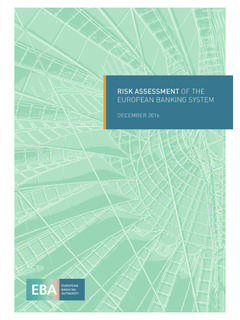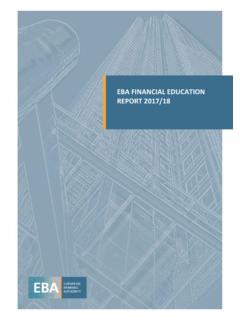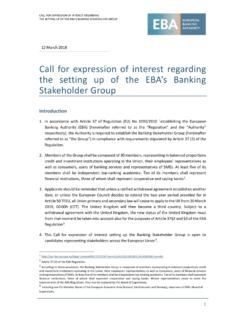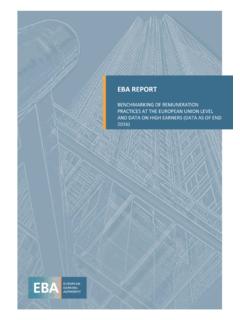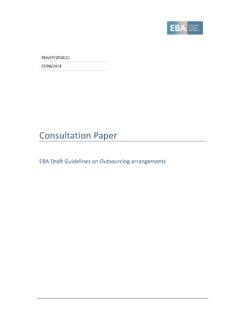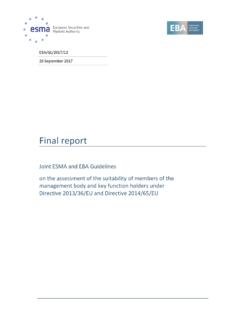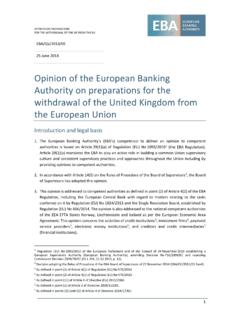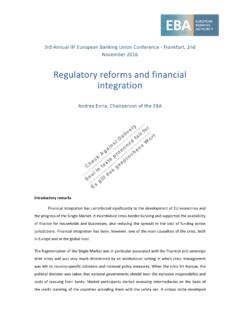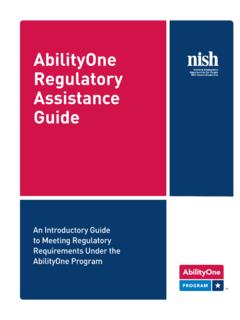Transcription of Joint Committee Final Report on Big Data - …
1 JC/2018/04. 15 March 2018. Joint Committee Final Report on Big Data 1. Contents 1. Overview .. 4. 2. Contents .. 4. 3. Executive summary .. 6. 4. Feedback statement .. 8. A. Description of the Big Data phenomenon .. 8. B. Level playing field and fair competition .. 9. C. Impact of Big Data on financial inclusion, comparability and pricing practices .. 11. D. Potential shortcomings in the transparency of Big Data tools .. 14. E. Accuracy of data - Fair and transparent use of data collected .. 14. F. Cyber risks .. 15. G. Potential systemic risks .. 17. H. Role of regulators/supervisory authorities .. 17. I. General comments on potential benefits and risks .. 18. J. Potential non-regulatory barriers to the use of Big Data.
2 21. K. Potential Additional existing legal requirements .. 21. L. Potential development of Artificial Intelligence (AI) and Big Data .. 22. 5. Preliminary conclusions of the ESAs .. 23. A. 23. B. Requirements in the European data protection, cybersecurity and consumer protection legislation .. 24. C. Requirements under the sectorial financial legislation .. 28. D. Good practices for financial institutions using Big Data .. 32. 2. Acronyms and definitions AIFMD Alternative Investment Fund Manager Directive (2011/61/EC). AMLD Anti-Money Laundering Directive (2015/849). CRD IV Capital Requierements Directive (2013/36/EU). EBA European Banking Authority EIOPA European Insurance and Occupational Pensions Authority EMD E-Money Directive (2009/110/EC).
3 ESAs European Supervisory Authorities ESMA European Securities and Markets Authority GDPR Regulation on the protection of natural persons with regard to the processing of personal data and on the free movement of such data (General Data Protection Regulation) (679/2016/EU). IDD Insurance Distribution Directive (2016/97/EC). MCD Mortgage Credit Directive (2014/17/EU). MiFID II Markets in Financial Instruments Directive (2014/65/EC). NIS Directive concerning measures for a high common level of security of network and information systems across the Union (2016/1148/EU). PSD Payment Services Directive (2007/63/EC). PSD2 Revised Payment Services Directive II (2015/2366). PSPs Payment service providers UCPD Directive concerning unfair business-to-consumer commercial practices in the internal market (Unfair Commercial Practices Directive) (2005/29/EC).
4 3. 1. Overview 1. One of the tasks of the European Banking Authority (EBA), the European Securities and Markets Authority (ESMA) and the European Insurance and Occupational Pensions Authority (EIOPA), collectively referred to as the European Supervisory Authorities (ESAs), is to monitor any emerging risks for consumers and financial institutions as well as new and existing financial activities and to adopt measures, where needed, with a view to promoting consumer protection and the safety and soundness of markets and convergence in regulatory practices. The coordination of the ESAs' actions in these areas takes place within the Joint Committee . 2. In monitoring consumer protection developments and financial innovations, the ESAs have noted the continued increase in the use of Big Data, albeit to varying extents, across the banking, insurance and securities sectors and across different EU Member States.
5 3. As a consequence, the 2016 Work Programme of Joint Committee of the European Supervisory Authorities1 mandated its Sub- Committee on Consumer Protection and Financial Innovation to work on the opportunities and challenges of the use of Big Data by financial institutions. 4. On 19 December 2016, the Joint Committee issued a Discussion Paper on the use of Big Data by financial institutions2. 5. Stakeholders were asked to respond to the questions raised in the Discussion Paper by 17 March 2017. 6. A total of 68 responses were received. Public responses are published on the ESMA's 2. Contents 7. Section 3 of this Final Report contains an executive summary summarising the key aspects of the various sections of the Final Report .
6 8. Section 4 contains a detailed feedback statement which summarises, through the angle of 12 key topics, the feedback received from stakeholders and the ESAs' reaction in response to some of the issues raised by respondents. 9. Most of the comments made by the ESAs in Section 4 (ESAs' reaction) are further developed in Section 5 which sets out the ESAs conclusions including a reference to some existing requirements deriving from European financial 1 2016 Work Programme of Joint Committee of the European Supervisory Authorities - Available here. 2 Joint Committee Discussion Paper on the use of Big Data for Financial Institutions Available here. 3 Available here. 4. and non-financial legislation which are relevant to the use of Big Data techniques by financial institutions as well as a list of items that could be used by financial institutions to develop good practices in relation to the use of Big Data.
7 5. 3. Executive summary 10. The responses received from stakeholders generally coincided with the content of the Discussion Paper, particularly with regards to the challenges and opportunities identified. Yet, the feedback received enabled to nuance some of the statements contained in the Discussion Paper and to better inform the ESAs assessment of the use of Big Data across the three sectors and its impact on the financial sector as a whole. 11. The respondents generally agreed with the tentative definition and description of the Big Data phenomenon provided in the Discussion Paper, while highlighting that any definition of a fast evolving phenomenon such as Big Data should remain flexible to accommodate inevitable adjustments.
8 12. The respondents noted that the accuracy of the data used in Big Data analyses is of utmost importance and expressed concerns regarding practices that do not guarantee the accuracy of the data collected (such as the gathering of data from social media), which could lead to erroneous decisions based on this inaccurate data or on spurious correlations arising from it. There was however a quite wide agreement on the fact that the entry into application of new legislation including the GDPR4 (General Data Protection Regulation) will help mitigate risks in this field. 13. Many respondents raised concerns regarding the potential consequences of the increasing level of segmentation of customers enabled by Big Data on the comparability availability, affordability and pricing practices of products and services, although to date there is limited evidence of such risks materialising.
9 Some respondents pointed out the overarching obligation of financial institutions to treat customers fairly and the need to ensure that sensitive data are only used based on the consumers' informed consent and only for limited purposes. Some stakeholders also warned that consumers may not be fully aware of Big Data tools being used and stressed the need to increase transparency for consumers to enable them to better understand and control the use of their data. 14. A number of respondents also highlighted that the growing use of Big Data could increase the breadth of the consequences of cyber risks attacks. On this issue, the ESAs clarify that a number of requirements have been enacted in recent years at the European level aiming at the prevention of cyber risks.
10 This Final Report also highlights the existence of European Union legislation specifically aiming at tackling information and systems risks. 15. Respondents also highlighted the numerous benefits arising from Big Data. A large number of respondents (across the three sectors) agreed that the 4 The GDPR will enter into application from 25 May 2018. 6. use of Big Data techniques could help financial institutions to develop products better tailored to the needs of their target market and support the implementation of product governance and foster the development, distribution and monitoring of products, as well as the broader supervision of product governance requirements. Other benefits arising from Big Data highlighted by respondents included enhancing the efficiency of the internal procedures inside the organisations, improving the fight against fraud, or enabling better customer-client interactions.
